Browse Primary Sources
Locate primary sources, including images, objects, media, and texts. Annotations by scholars contextualize sources.
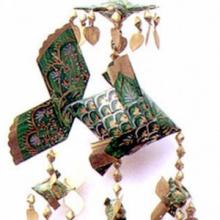
Thai Palm Leaf Fish Mobile for the Cradle
The fish mobile above is a type traditionally hung over the cradle in Thailand. It is made from the folded, woven leaves of the palm, especially in Phra Nakhon Si Ayutthaya province. The fish depicted is the Thai barb, or carp, which is a symbol of prosperity. The smaller fish, the offspring of the larger one, are thought to symbolize fertility.
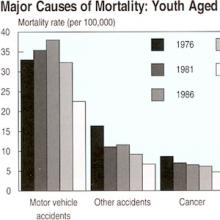
1996 New Zealand Census Information
These tables give details on three health-related facets of young New Zealanders' lives as interpreted from data recorded in the 1996 Census: levels of educational qualification in school leavers, unemployment rates, and youth mortality.
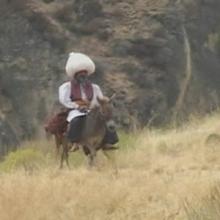
Goha Gives His Son a Lesson About People
The anecdote is a lesson to a child who is probably at the adolescent stage of life, and very concerned with how peers and others view him. The experience of the father and son pair shows the futility of trying to act on fickle public opinion.
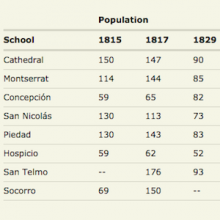
School Population in Buenos Aires, Argentina
This chart demonstrates the fluctuating attendance rates of school aged children in a select number of schools in Buenos Aires between 1815 and 1831. This is not a complete list of the port city’s schools; it represents schools that maintained the most complete attendance records.
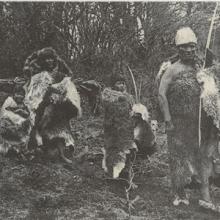
Ona Family Group of Tierra del Fuego
Father Alberto Maria De Agostini, a missionary, took this postcard image on Isla Grande, Tierra del Fuego, on the southernmost tip of South America. The photograph, taken circa 1930, shows a man, woman, and two children walking through a clearing surrounded by thickets.
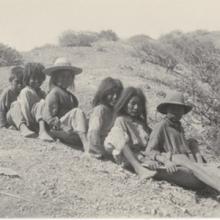
Seri Children Sliding on Turtle Shells
Six children of the Seri indigenous people slide down a hill using the shells of sea turtles as sleds, illustrating the universal ability of children to create play activities including equipment out of things in their environment.
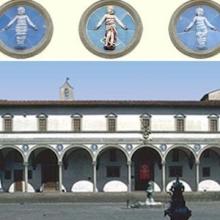
Swaddled Children Terra Cotta Bas-Reliefs
These images of swaddled infants come from a series of 10 glazed terra cotta bas-reliefs known as the "bambini." Andrea della Robbia sculpted them between 1463 and 1466 to adorn the Ospedale degli Innocenti, or Foundling Hospital, in Florence, Italy.
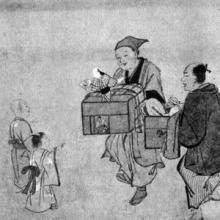
Puppeteers Painting
This is an ink painting on a scroll by Hanabusa Itchô (born Taga Shinkô), a Japanese artist of the early Tokugawa period (1600–1868). Tokugawa artists typically used pen names and Itchô used several names at different times as an artist and poet.
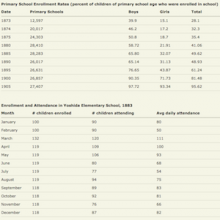
Meiji Era School Attendence
Below are two tables that reveal both the accomplishments and the limitations of Meiji educational reforms. Table 1 shows an impressive increase in the number of schools and the enrollment rates for both girls and boys, one that culminates in 1905 with near-universal enrollment rates. Table 2, however, reveals the fact that enrollment rates and attendance rates were not identical.
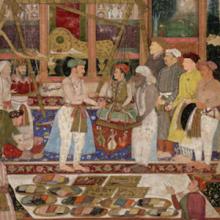
Emperor Jahangir Weighing His Son Khurram in Gold
The finely detailed miniature painting in an album created for the Emperor Jahangir (reigned 1605–1627) of the Mughal Empire in India shows a ceremony initiated by Jahangir's father, Akbar the Great (reigned 1556-1605), Jahangir's father.
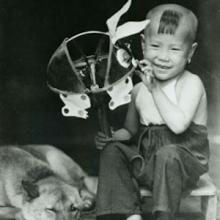
Tet Trung Thu Festival in Vietnam
The photographs show children during the mid-Autumn Harvest Festival, or Tet Trung Thu in Vietnam, a children's festival associated with the full moon.
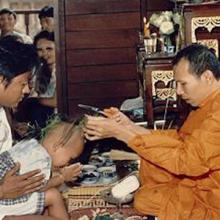
Custom of Cutting the Topknot in Thailand
The custom described in the text by Phya Anuman Rajadhon is presented as it was traditionally practiced in Central Siam. The head of an infant was shaven as part of the khwan ceremony celebrating its survival and welcoming into the family. Some of the hair over the soft part of the infant's skull was left to grow into a topknot, to be cut in another ceremony when the child came of age.
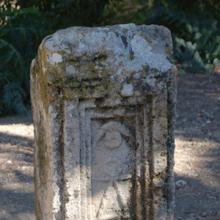
Tophet of Carthage
These images show a stone grave marker carved with symbols and a terracotta funerary urn containing the charred remains of an infant. The Tophet of Carthage is a cemetery for infants in the ruins of the North African city of Carthage, now located in a suburb of Tunis. It was once located on the edge of ancient Carthage, which was destroyed by the Romans in 146 BCE.
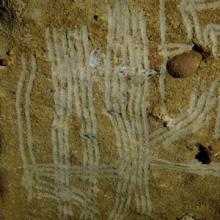
Paleolithic Finger Flutings Cave Drawing
This image from Chamber A1 of Rouffignac Cave was created by a young girl we posit to be between four and five years old from her height and the places in the cave where she has chosen to make her flutings. She was part of a group of people who visited the cave during the Upper Paleolithic Period (sometime between 20,000 and 11,000 years ago).
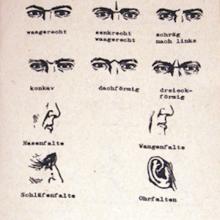
Facial Recognition Manual
If they wanted to keep out spies, security personnel on both sides of the Berlin Wall had to become sophisticated readers of facial features. This manual, prepared by the East German border police as a training text for their front line guards, shows the reader how to recognize someone from telling facial features.
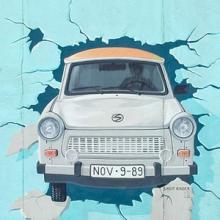
Berlin Wall Trabant
This painting by Birgit Kinder is on a segment of the Berlin Wall that was on the east bank of the Spree River that separated portions of East and West Berlin. Because this section of the wall was on the opposite shore of the river, it was not covered by graffiti as was the case with the rest of the west face of the Wall (accessible to West Berliners).
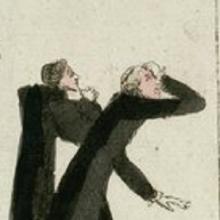
Patience Monsignor Your Turn Will Come
Cartoons attacked the refractory clergy. Here, fat, overfed, and underworked clergy are squeezed down to an appropriate size. As elsewhere, visual images mocked the clergy by depicting them as subject to the threats and physical attacks of others.
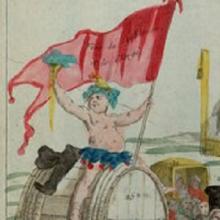
Refractory (Clergy) Going to the Promised Land
Many refractory clergy left France to join other detractors, as this print shows, or wishfully encourages. However, this is an ambiguous image, which leaves open the possibility that rather than joining foreign monarchies, the clergy are crossing the river leading to Hell.
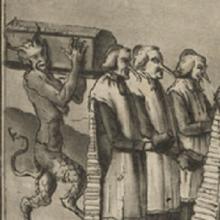
Procession of Refractory Clergy
Of particular interest in this caricature of refractory clergy here are the long noses, traditionally used to caricature Jews, that suggest the refractory clergy were not of the people. This image shows resistant clergy marching in their last procession. The satyr at the rear with a coffin seems to threaten their very lives.
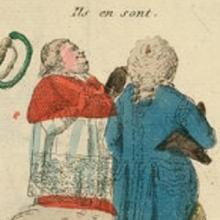
The Roman Aristocrat
The fattened clergyman and the well–bedecked nobleman go off unbothered while the figure in the foreground assesses carefully the value of a commoner. This complex image also includes a pig—likely a symbol for Louis XVI—with the cleric and the noble. Thus the print clearly attacks the upper classes and likely the monarch. But there is more.